Презентация education in great britain
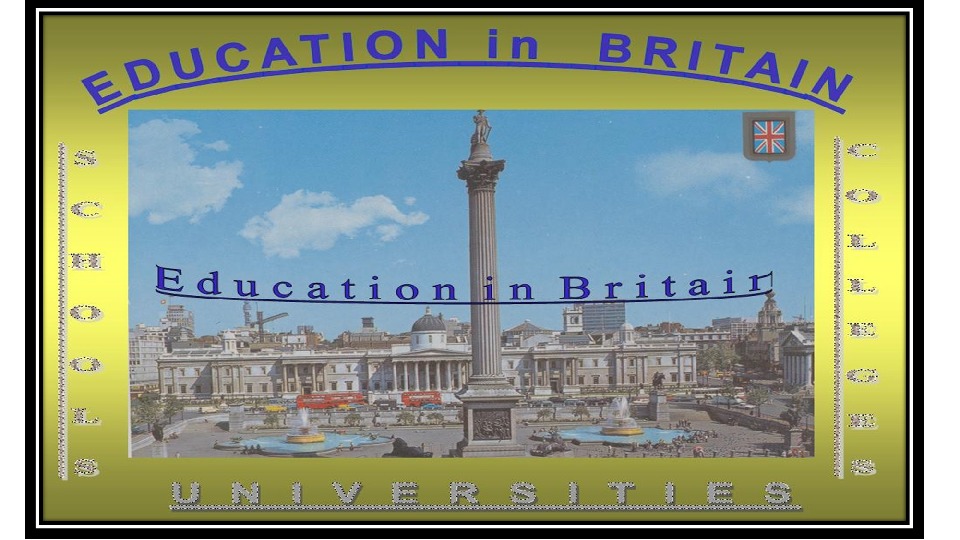
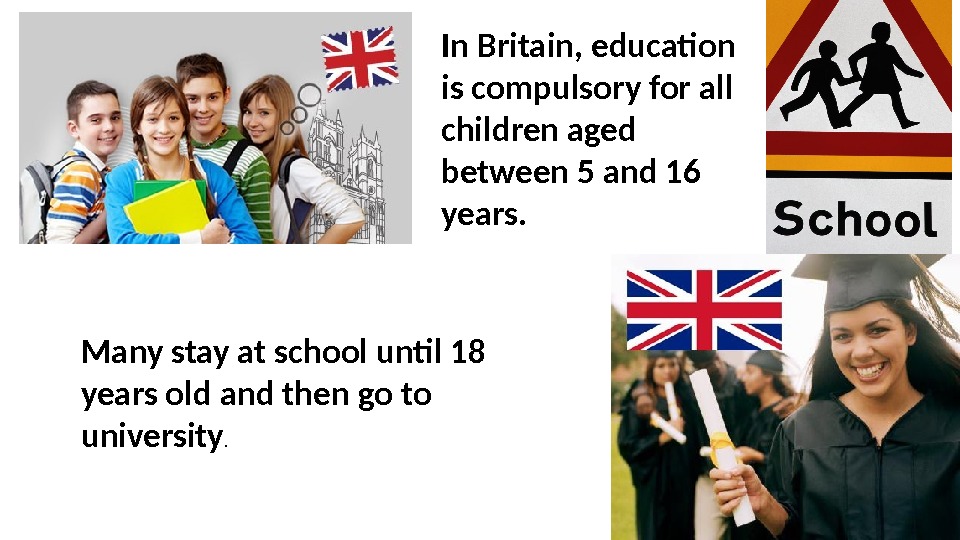

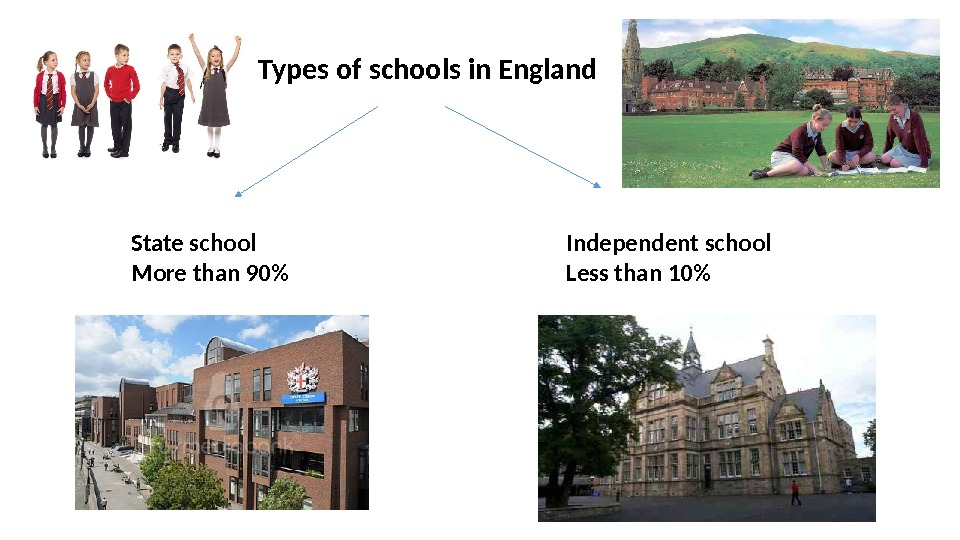

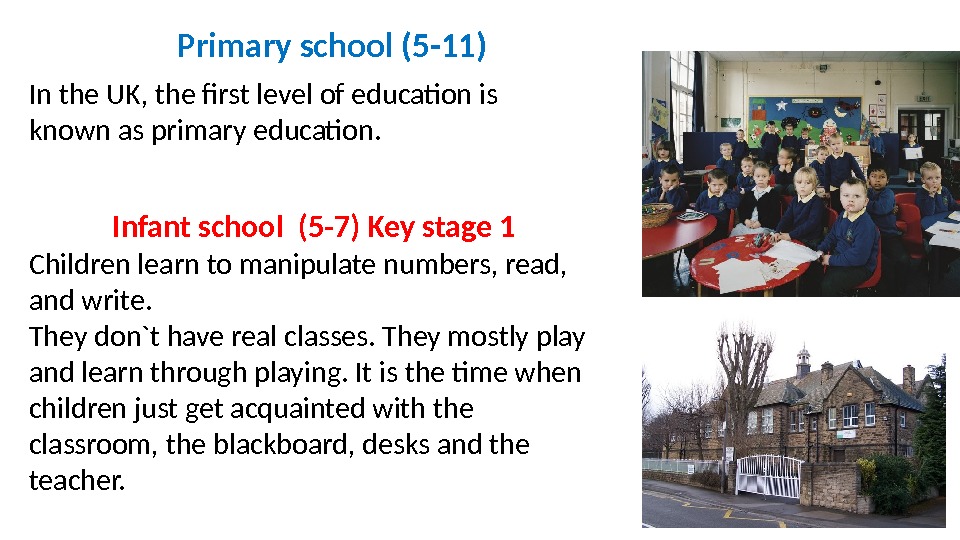
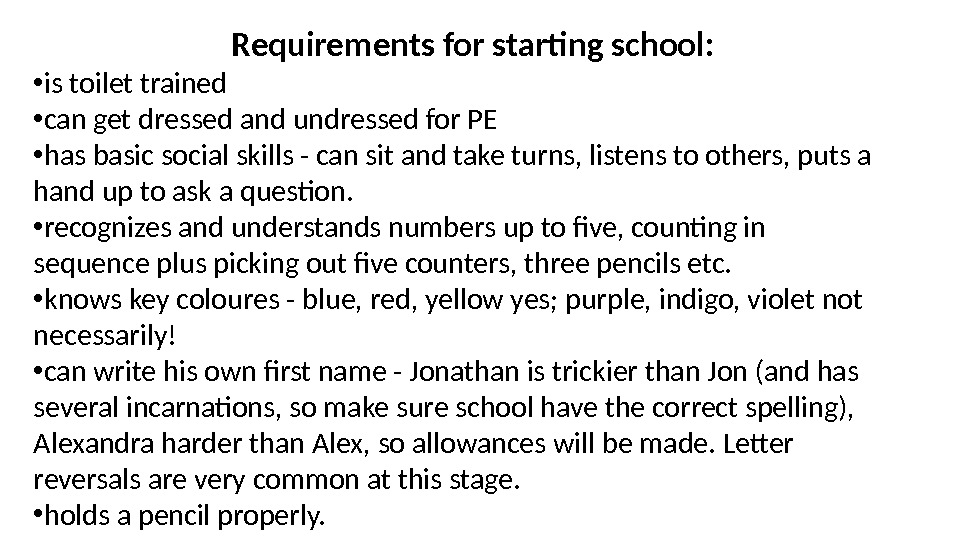




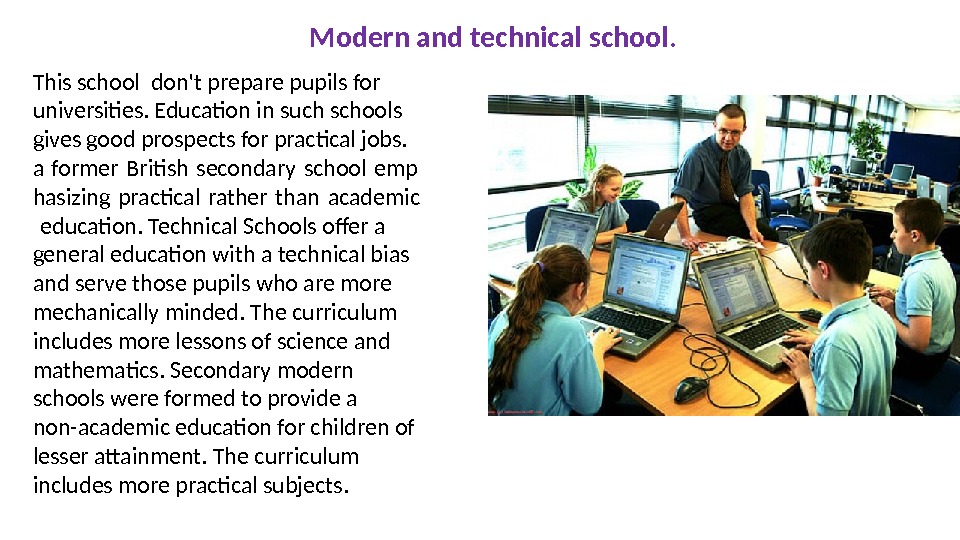
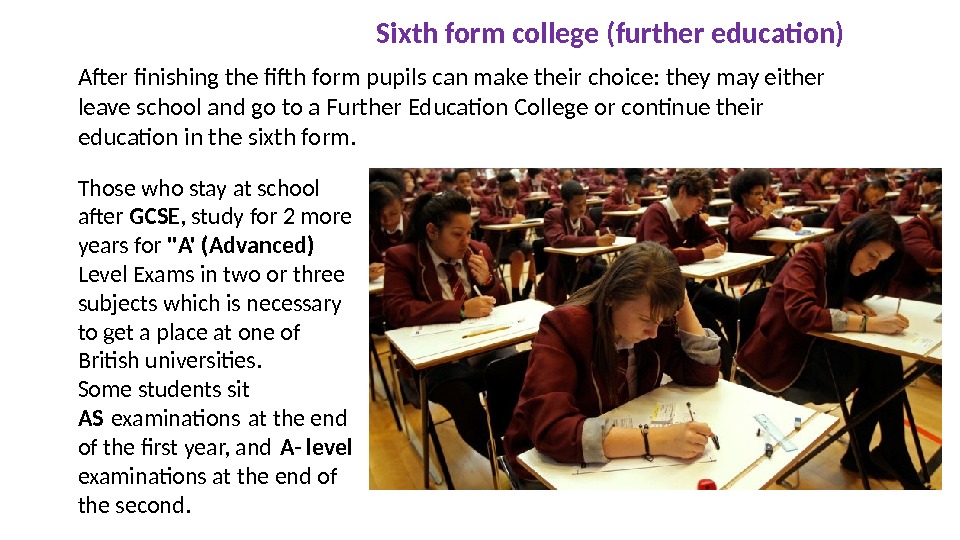

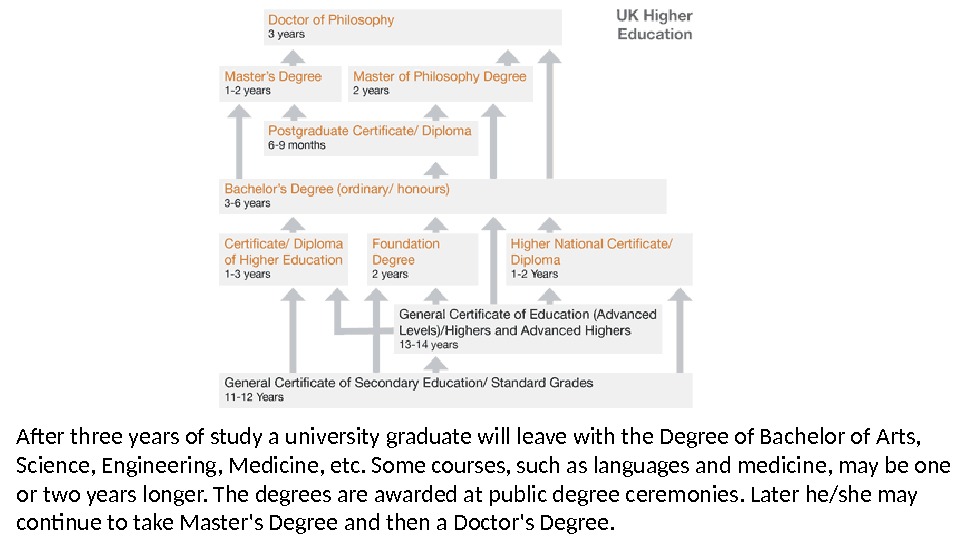
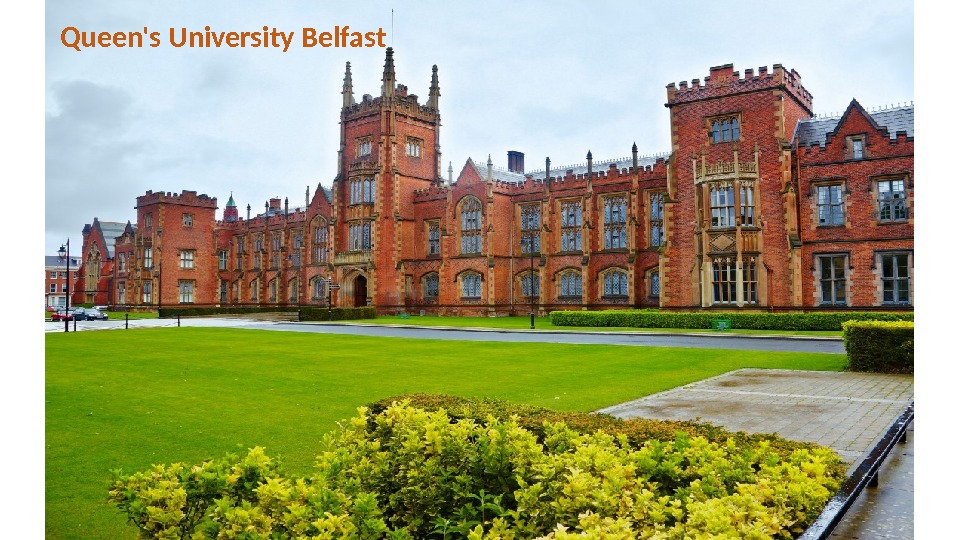
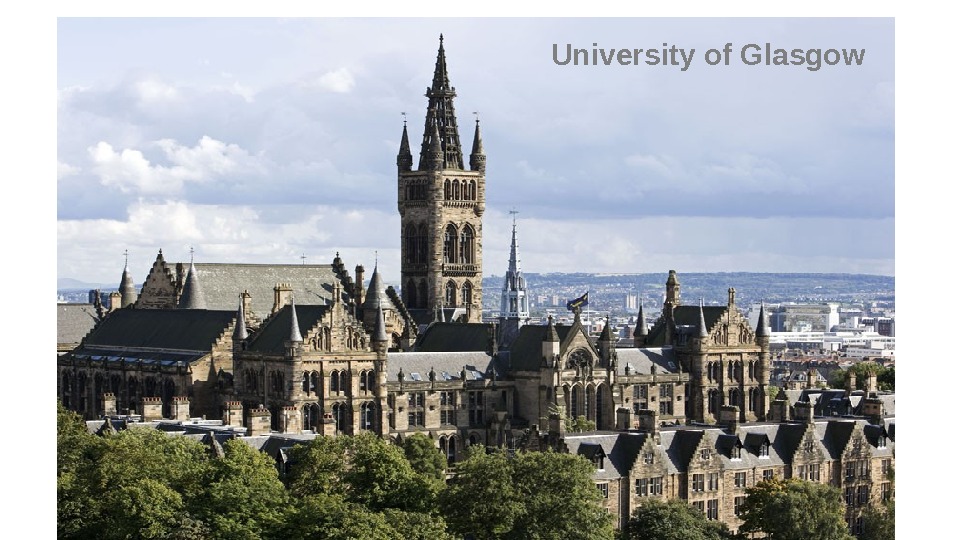
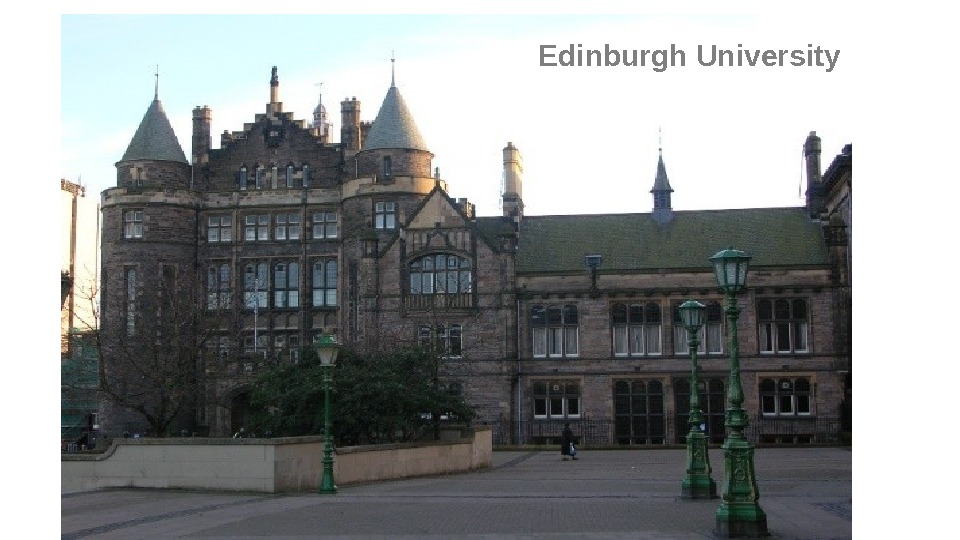
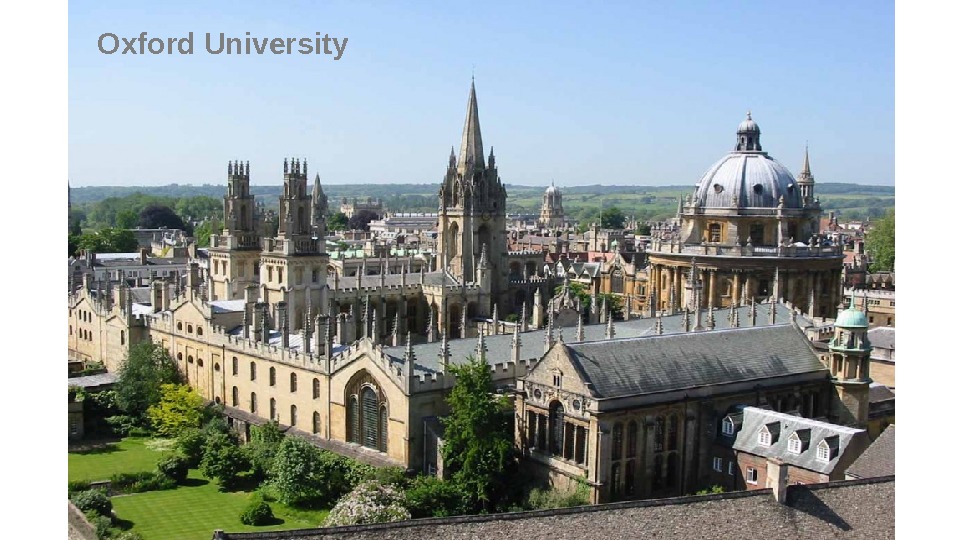
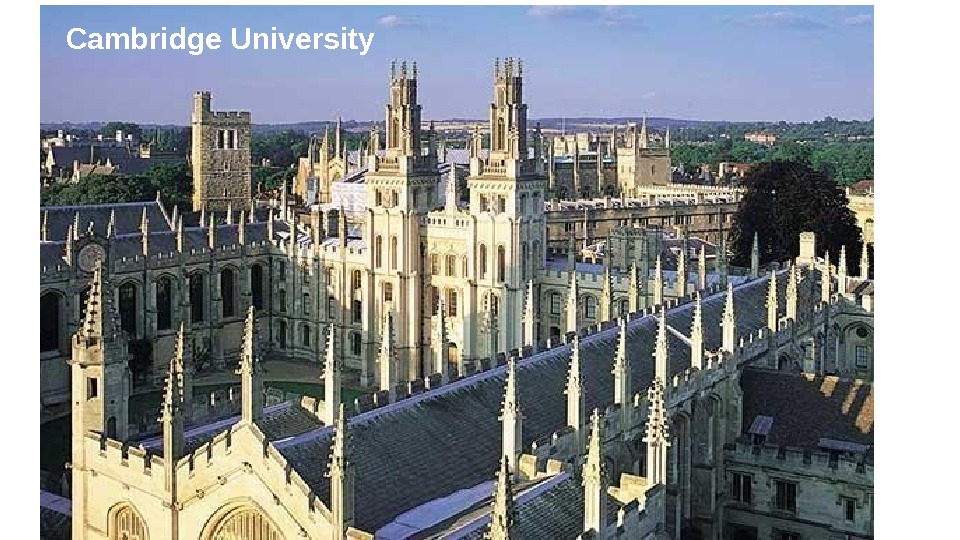

- Размер: 6.8 Mегабайта
- Количество слайдов: 21
Описание презентации Презентация education in great britain по слайдам

 Many stay at school until 18 years old and then go to university. In Britain, education is compulsory for all children aged between 5 and 16 years.
Many stay at school until 18 years old and then go to university. In Britain, education is compulsory for all children aged between 5 and 16 years.

 Types of schools in England State school More than 90% Independent school Less than 10%
Types of schools in England State school More than 90% Independent school Less than 10%
 Nursery schools or kindergartens (2 -5) Nursery school will provide a good opportunity for him to mix with other children of a similar age and increase his independence before he starts ‘big school’. schools they learn some elementary things such as numbers, colours, and letters. Apart from that, babies play, have lunch and sleep there. Whatever they do, there is always someone keeping an eye on them. Personal, social and emotional development (prime area) Communication and Language (prime area) Physical education (prime area) Literacy (specific area) Mathematics (specific area) Understanding the World (specific area) Expressive Art & Design (specific area)
Nursery schools or kindergartens (2 -5) Nursery school will provide a good opportunity for him to mix with other children of a similar age and increase his independence before he starts ‘big school’. schools they learn some elementary things such as numbers, colours, and letters. Apart from that, babies play, have lunch and sleep there. Whatever they do, there is always someone keeping an eye on them. Personal, social and emotional development (prime area) Communication and Language (prime area) Physical education (prime area) Literacy (specific area) Mathematics (specific area) Understanding the World (specific area) Expressive Art & Design (specific area)
 Primary school (5 -11) In the UK, the first level of education is known as primary education. Infant school (5 -7) Key stage 1 Children learn to manipulate numbers, read, and write. They don`t have real classes. They mostly play and learn through playing. It is the time when children just get acquainted with the classroom, the blackboard, desks and the teacher.
Primary school (5 -11) In the UK, the first level of education is known as primary education. Infant school (5 -7) Key stage 1 Children learn to manipulate numbers, read, and write. They don`t have real classes. They mostly play and learn through playing. It is the time when children just get acquainted with the classroom, the blackboard, desks and the teacher.
 Requirements for starting school: • is toilet trained • can get dressed and undressed for PE • has basic social skills — can sit and take turns, listens to others, puts a hand up to ask a question. • recognizes and understands numbers up to five, counting in sequence plus picking out five counters, three pencils etc. • knows key coloures — blue, red, yellow yes; purple, indigo, violet not necessarily! • can write his own first name — Jonathan is trickier than Jon (and has several incarnations, so make sure school have the correct spelling), Alexandra harder than Alex, so allowances will be made. Letter reversals are very common at this stage. • holds a pencil properly.
Requirements for starting school: • is toilet trained • can get dressed and undressed for PE • has basic social skills — can sit and take turns, listens to others, puts a hand up to ask a question. • recognizes and understands numbers up to five, counting in sequence plus picking out five counters, three pencils etc. • knows key coloures — blue, red, yellow yes; purple, indigo, violet not necessarily! • can write his own first name — Jonathan is trickier than Jon (and has several incarnations, so make sure school have the correct spelling), Alexandra harder than Alex, so allowances will be made. Letter reversals are very common at this stage. • holds a pencil properly.
 Junior school (7 -11) Key stage 2 They don’t already play so much as they did it in infant school. Now they have real classes, when they sit at desks, read, write and answer the teacher’s questions. The major goals of primary education are achieving basic literacy and numeracy among all pupils, as well as establishing foundations in science, mathematics, geography, history and other social sciences. Pupils were streamed according to their abilities to learn into A, B, С and D streams. The least gifted are in the D stream. At the end of Key Stage 2 all children in state primary schools are required to take National Curriculum tests in reading and mathematics also called SATs.
Junior school (7 -11) Key stage 2 They don’t already play so much as they did it in infant school. Now they have real classes, when they sit at desks, read, write and answer the teacher’s questions. The major goals of primary education are achieving basic literacy and numeracy among all pupils, as well as establishing foundations in science, mathematics, geography, history and other social sciences. Pupils were streamed according to their abilities to learn into A, B, С and D streams. The least gifted are in the D stream. At the end of Key Stage 2 all children in state primary schools are required to take National Curriculum tests in reading and mathematics also called SATs.
 ● Secondary schools provide compulsory education for children between the ages of eleven and sixteen in England Wales. From the ages of fourteen to sixteen, pupils study for the General Certificate of Secondary Education (GCSE). ● Pupils who stay on at school from the ages of sixteen to eighteen in England, may take the Advanced (A) level examination , which traditionally is required for entry into higher education. ● Compulsory secondary education begins when children are 11 or 12 and lasts for 5 years. Secondary school is traditionally divided into 5 forms: a form to each year. ● Children study English, Mathematics, Science, History, Art, Geography, Music, a Foreign language and have lessons of Physical training. Religious education is also provided. English, Mathematics and Science are called «core» subjects. At the age of 7, 11 and 14 pupils take examinations in the core subjects. Secondary schools (11 -16) Key Stage 3 (11 -13), Key Stage 4 (14 -16)
● Secondary schools provide compulsory education for children between the ages of eleven and sixteen in England Wales. From the ages of fourteen to sixteen, pupils study for the General Certificate of Secondary Education (GCSE). ● Pupils who stay on at school from the ages of sixteen to eighteen in England, may take the Advanced (A) level examination , which traditionally is required for entry into higher education. ● Compulsory secondary education begins when children are 11 or 12 and lasts for 5 years. Secondary school is traditionally divided into 5 forms: a form to each year. ● Children study English, Mathematics, Science, History, Art, Geography, Music, a Foreign language and have lessons of Physical training. Religious education is also provided. English, Mathematics and Science are called «core» subjects. At the age of 7, 11 and 14 pupils take examinations in the core subjects. Secondary schools (11 -16) Key Stage 3 (11 -13), Key Stage 4 (14 -16)
 Comprehensive schools. About 90% of British pupils attend comprehensive schools. Nowadays schools of these types still exist, but the most popular type is comprehensive school introduced in 1965. A comprehensive school usually has the humanities, sciences and education with a practical bias combined under one roof. Pupils may change their specialisation inside one school. They take pupils of all abilities without exams. In such schools pupils are often put into certain sets or groups, which are formed according to their abilities for technical or humanitarian subjects. The main subjects at British schools are English, Mathematics, Geography, Art, Science, History, Physical Education, Information Technology, Music, Religious education and others.
Comprehensive schools. About 90% of British pupils attend comprehensive schools. Nowadays schools of these types still exist, but the most popular type is comprehensive school introduced in 1965. A comprehensive school usually has the humanities, sciences and education with a practical bias combined under one roof. Pupils may change their specialisation inside one school. They take pupils of all abilities without exams. In such schools pupils are often put into certain sets or groups, which are formed according to their abilities for technical or humanitarian subjects. The main subjects at British schools are English, Mathematics, Geography, Art, Science, History, Physical Education, Information Technology, Music, Religious education and others.
 Grammar school This type of school gives secondary education of a very high standard. Entrance is based on the test of ability, usually at 11. Grammar schools are single sexed schools; Some of the remaining grammar schools can trace their histories to before the 16 th century. This school offers a full theoretical secondary education including foreign languages, and students can choose which subjects and languages they wish to study. There are 164 grammar schools in England. There are no grammar schools in Wales and Scotland.
Grammar school This type of school gives secondary education of a very high standard. Entrance is based on the test of ability, usually at 11. Grammar schools are single sexed schools; Some of the remaining grammar schools can trace their histories to before the 16 th century. This school offers a full theoretical secondary education including foreign languages, and students can choose which subjects and languages they wish to study. There are 164 grammar schools in England. There are no grammar schools in Wales and Scotland.
 Modern and technical school. This school don’t prepare pupils for universities. Education in such schools gives good prospects for practical jobs. a former British secondary school emp hasizing practical rather than academic education . Technical Schools offer a general education with a technical bias and serve those pupils who are more mechanically minded. The curriculum includes more lessons of science and mathematics. Secondary modern schools were formed to provide a non-academic education for children of lesser attainment. The curriculum includes more practical subjects.
Modern and technical school. This school don’t prepare pupils for universities. Education in such schools gives good prospects for practical jobs. a former British secondary school emp hasizing practical rather than academic education . Technical Schools offer a general education with a technical bias and serve those pupils who are more mechanically minded. The curriculum includes more lessons of science and mathematics. Secondary modern schools were formed to provide a non-academic education for children of lesser attainment. The curriculum includes more practical subjects.
 Sixth form college ( further education) After finishing the fifth form pupils can make their choice: they may either leave school and go to a Further Education College or continue their education in the sixth form. Those who stay at school after GCSE , study for 2 more years for «A’ (Advanced) Level Exams in two or three subjects which is necessary to get a place at one of British universities. Some students sit AS examinations at the end of the first year, and A- level examinations at the end of the second.
Sixth form college ( further education) After finishing the fifth form pupils can make their choice: they may either leave school and go to a Further Education College or continue their education in the sixth form. Those who stay at school after GCSE , study for 2 more years for «A’ (Advanced) Level Exams in two or three subjects which is necessary to get a place at one of British universities. Some students sit AS examinations at the end of the first year, and A- level examinations at the end of the second.
 Higher education Good A-level results in at least 2 subjects are necessary to get a place at a university. However, good exam passes alone are not enough. Universities choose their students after interviews. For all British citizens a place at a university brings with it a grant from their local education authority. English universities greatly differ from each other. They differ in date of foundation, size, history, tradition, general organization, methods of instruction and way of student life. After finishing secondary school or college you can apply to a university, polytechnic, college of education or you can continue to study in a college of further education. There are 46 universities in Britain. The oldest and best-known universities are located in Oxford, Cambridge, London, Leeds, Manchester, Liverpool, Edinburgh, Southampton, Cardiff, Bristol and Birmingham.
Higher education Good A-level results in at least 2 subjects are necessary to get a place at a university. However, good exam passes alone are not enough. Universities choose their students after interviews. For all British citizens a place at a university brings with it a grant from their local education authority. English universities greatly differ from each other. They differ in date of foundation, size, history, tradition, general organization, methods of instruction and way of student life. After finishing secondary school or college you can apply to a university, polytechnic, college of education or you can continue to study in a college of further education. There are 46 universities in Britain. The oldest and best-known universities are located in Oxford, Cambridge, London, Leeds, Manchester, Liverpool, Edinburgh, Southampton, Cardiff, Bristol and Birmingham.
 After three years of study a university graduate will leave with the Degree of Bachelor of Arts, Science, Engineering, Medicine, etc. Some courses, such as languages and medicine, may be one or two years longer. The degrees are awarded at public degree ceremonies. Later he/she may continue to take Master’s Degree and then a Doctor’s Degree.
After three years of study a university graduate will leave with the Degree of Bachelor of Arts, Science, Engineering, Medicine, etc. Some courses, such as languages and medicine, may be one or two years longer. The degrees are awarded at public degree ceremonies. Later he/she may continue to take Master’s Degree and then a Doctor’s Degree.
 Queen’s University Belfast
Queen’s University Belfast
 University of Glasgow
University of Glasgow
 Edinburgh University
Edinburgh University
 Oxford University
Oxford University
 Cambridge University
Cambridge University

